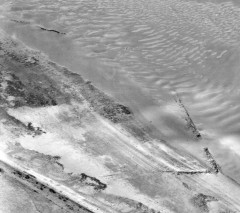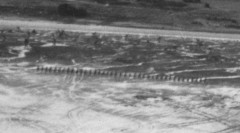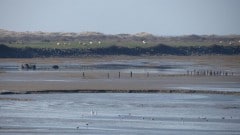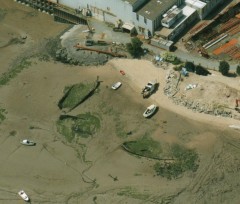The aerial photographs clearly demonstrate the effect coastal change has had on the coastline and on the historic environment. Pertinent examples are some of the Second World War structures visible on aerial photographs in the 1940s on vegetated dunes at Crow Point, their locations now are on or very close to the foreshore (MDV102738; MDV102741).
Coastal change is not a new phenomenon, as is illustrated by the submerged land surface at Westward Ho!. Deposits of peat, preserved tree stumps, stone tools and shell middens (MDV44568; MDV468; MDV14854) have been dated to the Mesolithic, evidence of people gathering seafood here six and a half millennia ago, before the widespread adoption of agriculture. The submerged ground surface is visible as dark organic deposits, exposed by shifting sands to a greater or lesser degree, on aerial photographs from the 1940s onwards (MDV102445).
 Westward Ho! submerged land surface in the 1980s. Photograph: Devon County Council
Westward Ho! submerged land surface in the 1980s. Photograph: Devon County Council
Waterlogged stakes had been preserved within the areas of peat. Some have been dated to the Neolithic as possible trackway structures (MDV44569), and others, suggested to be part of a fish trap, to the Roman period (MDV44570). These structures were not visible on the aerial photographs available to the survey team, but numerous V-shaped intertidal fish traps were recorded at other locations including Crow Point (MDV102756; MDV102757 and MDV102755) and Horsey Island (MDV66207).

Horsey Weir fishtrap RAF/543/1017 PSFO-0131 SS4831-2 10-AUG-1960

Some intertidal structures are more enigmatic. Posts on the Skern at Northam Burrows are visible in a grid pattern on aerial photographs from 1944 onwards (MDV102560). They could have been part of the infrastructure for D-Day military training, and also resemble oyster racks in their size and layout, 
Post structure on the Skern, Northam, in 2013. Photograph: Stephanie Knight
As expected, numerous hulks were visible submerged in the intertidal sands. The remains of an East Indiaman (MDV50848) wrecked in the late eighteenth century at Westward Ho! was visible on aerial photographs from the 1980s onwards, and is periodically visible on the beach. Let us know if you’ve seen it lately! Another hulk was temporarily visible in the 1960s at Crow Point (MDV102746).

On the Torridge estuary, a group of three hulks at Boathyde (MDV53867) appear to be becoming subsumed by sand, while four north-east of Snuffy Corner (MDV53865) seem to have become more exposed over time, illustrating the dynamic nature of the intertidal environment. Many vessels are likely to have been brought into boatyards for salvage, such as Henry Hinks’ breakers yard on the Skern, Northam (MDV102548 and MDV102545). These hulks are particularly mobile, one apparently shifting 25 metres in four years.
Preece, C. 2005 ‘A Conflict of Interests: the Fish Traps of the Taw and Torridge Estuaries’ Proceedings of the Devon Archaeological Society 53: 139-165.